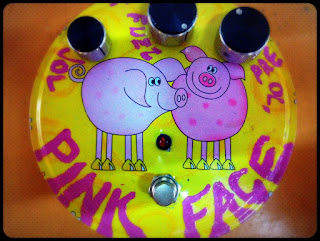 |
| The Led Bender mkII |
The UK fuzz mania began in 1965 probably after the Rolling Stones recorded the 3 fuzz notes that changed the history of rock'n roll: the opening notes for their hit "Satisfaction". First recorded on Brian Jones' Harmonica in Chicago and 2 days later by Richards using a Maestro Fuzz Tone, the opening notes were meant to be replaced with a horn section later on, but luckily producer Andrew Oldham decided to keep it as it was. The song was an immediate hit across both sides of the Atlantic and fuzz was the talk of the day. Guitar legend Vic Flick, the man begind the James Bond Theme, brought the American Fuzz-tone (FZ-1) to the UK and asked electronics engineer Gary Stewart Hurst if he could modify the unit to increase the tone sustain. Hurst used a similar 3 transistors architecture and designed the first Tone Bender, referred today as the mkI. Within a year or so a plethora of fuzz pedals were issued by various brands like the Arbiter Fuzz Face and the Baldwin Burns Buzzaround. While the Fuzz Face became the most famous fuzz of them all, the Tone Bender was probably the highest selling unit ever due to the fact that it was issued under various brands like Sola Sound, Vox, Rotosound and Marshall. The MKI version was made famous by the Beatles (Rubber Soul), Mick Ronson (Ziggy's Spiders from Mars), Pete Townsend and Jeff Beck.
 |
| Jimmy Pages' Bender original receipt (left) and the Sola Sound reissue of the mkII (right) |
Despite its legendary sound, the Tone Bender mkI's sound and design was not flawless. Circuit was sensitive to gain tolerances of the transistors and the sound was buzzier than some wanted. A new 2 transistor design was issued by Sola Sound and is referred to as mk1.5. This design could probably be the original 2 transistor design which Arbiter issued during 1966 as the Fuzz Face. The circuit was more stable, the sound was richer and saturation was not too heavy. The huge success of the Fuzz Face drove the competition further and Sola Sound made the leap to a 3 transistor architecture but this time it was a first amplification stage driving a Fuzz Face style 2 tranny stage with Germanium OC75 or OC81D were used on all 3. Different brands featured similar mkII design using various transistors, and they all were successful throughout the late 60's and 70's. When referring to legends like Jimmy Page and his tone on the Led Zeppelin I and II albums from 1969 the Tone Bender mkII is considered to be a major factor.
 |
| The Led Bender mkII |
Even more variant and diverse than the Tone Bender mkII of the Fuzz Faces is the Tone Bender mkIII which was issued 1968 and sparked a whole different era of fuzz pedals which led to the birth of the Big Muff.
After building more then a few fuzz pedals I decided to get into the Tone Bender jungle. I realized that I really wanted the mkI and the mkII, but the mkI seemed tricky and risky so I took the mkII path. Now Germanium trannys are always expensive and I found some silicon versions which got good reviews so I decided to give it a go.
After many unsuccessful attempts on various schematics I found one which worked, sounded good and by replacing trannys I really managed to get that bendery tone I was aiming for: Raw, punchy and versatile. Once you go for the Whole Lotta Love riff with humbuckers or How Many More Times with a Tele, you'll know this is the one.
I started with the GGG NPN design modded by J. Orman and B. Trembley which is a good choice. You can find the schematic here, but I really wanted to have the extra Tone control so I went the Hot Silicon path designed by Gus Smalley. The schematic is shown here. The two designs are quite alike and sound more or less the same depending on the transistors used. I took Mictester's and JD Sleep's advise of putting low gain sets and went to buy the 2N2369 parts instead of BC109C or 2N5088. I ended up using 2N2369 for Q1, 2N3904 for Q2, BC109C for Q3 and 2N2369 for Q4 for the TONE stage. I also liked the FAT switch which switches between low and high values of the input cap. Once I got that Jimmy Page sound I called it a day and painted the new Led Bender in a Zeppelin homage style.
 |
| Gut shot of the Led Bender. VR1 is a pot on the right side. Might as well change it to a board resistor. |
I am sure this is not the end of my Tone Bender phase but it sure sounds great, I am getting a friend to lend me his Sola Sound reissue of the mkII professional and I'll compare the two. Meanwhile I play Good Times Bad Times using this little baby connected to the Runoffgroove Supro amp emulation pedal and with the right reverb I can nail that super tone. A major milestone in my Fuzz quest.










